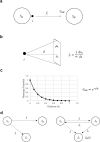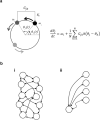Synthesis of causal and surrogate models by non-equilibrium thermodynamics in biological systems
- PMID: 38200211
- PMCID: PMC10781949
- DOI: 10.1038/s41598-024-51426-8
Synthesis of causal and surrogate models by non-equilibrium thermodynamics in biological systems
Abstract
We developed a model to represent the time evolution phenomena of life through physics constraints. To do this, we took into account that living organisms are open systems that exchange messages through intracellular communication, intercellular communication and sensory systems, and introduced the concept of a message force field. As a result, we showed that the maximum entropy generation principle is valid in time evolution. Then, in order to explain life phenomena based on this principle, we modelled the living system as a nonlinear oscillator coupled by a message and derived the governing equations. The governing equations consist of two laws: one states that the systems are synchronized when the variation of the natural frequencies between them is small or the coupling strength through the message is sufficiently large, and the other states that the synchronization is broken by the proliferation of biological systems. Next, to simulate the phenomena using data obtained from observations of the temporal evolution of life, we developed an inference model that combines physics constraints and a discrete surrogate model using category theory, and simulated the phenomenon of early embryogenesis using this inference model. The results show that symmetry creation and breaking based on message force fields can be widely used to model life phenomena.
© 2024. The Author(s).
Conflict of interest statement
The authors declare no competing interests.
Figures






Similar articles
-
Biological thermodynamics: Ervin Bauer and the unification of life sciences and physics.Biosystems. 2024 Jan;235:105089. doi: 10.1016/j.biosystems.2023.105089. Epub 2023 Nov 22. Biosystems. 2024. PMID: 38000544
-
Identifying causality drivers and deriving governing equations of nonlinear complex systems.Chaos. 2022 Oct;32(10):103128. doi: 10.1063/5.0102250. Chaos. 2022. PMID: 36319303
-
Homeostasis and information processing: The key frames for the thermodynamics of biological systems.Biosystems. 2024 Feb;236:105115. doi: 10.1016/j.biosystems.2023.105115. Epub 2023 Dec 30. Biosystems. 2024. PMID: 38163548
-
Physical causality and brain theories.Am J Physiol. 1980 May;238(5):R277-90. doi: 10.1152/ajpregu.1980.238.5.R277. Am J Physiol. 1980. PMID: 6990792 Review.
-
Thermodynamics of stoichiometric biochemical networks in living systems far from equilibrium.Biophys Chem. 2005 Apr 22;114(2-3):213-20. doi: 10.1016/j.bpc.2004.12.001. Epub 2004 Dec 22. Biophys Chem. 2005. PMID: 15829355 Review.
Cited by
-
Medical AI and AI for Medical Sciences.JMA J. 2025 Jan 15;8(1):26-37. doi: 10.31662/jmaj.2024-0185. Epub 2024 Nov 25. JMA J. 2025. PMID: 39926067 Free PMC article. Review.
References
-
- Mayr E. Toward a new philosophy of biology. Harvard Univ; 1988.
-
- Mitchell M. Complexity: Guide tour. Oxford Univ; 2009.
-
- Oono Y. The Nonlinear World: Conceptual Analysis and Phenomenology. Springer (2012).
-
- Pawar U., O’Shea D., Rea S. and O’Reilly R. Explainable AI in Healthcare. International Conference on Cyber Situational Awareness, Data Analytics and Assessment (CyberSA), Dublin, Ireland, 1–2, (2020)
MeSH terms
LinkOut - more resources
Full Text Sources
Research Materials

